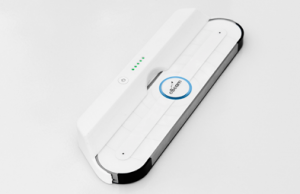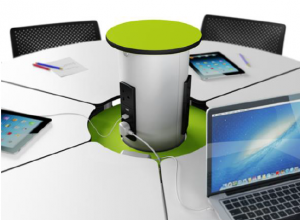I spent yesterday at BETT (the British Educational Training and Technology Show). BETT is a giant exhibition for vendors of Educational Technologies. I went along with colleagues from IS and PAF to investigate classroom technologies. This year I found some really innovative solutions to provide power in flexible spaces, and for capturing whiteboards, however the most interesting part of my day was when I took part in a focus group run by a marketing company on behalf of BETT.
Every year there is always a new trend at BETT, within minutes of walking through the door you usually become aware of this years solution – usually a practical solution to a well know issue in Education. This years problem was around power sockets – the promotion of active learning in teaching spaces has been something that all areas of Education have been involved in over the last couple of years, and as a result flexible furniture has been really popular. However this contrasts with trends in mobile technologies and therefore students needing a fixed point in the room in order to charge mobile devices and laptops in their classes.
 At City University we have promoted active learning by adding furniture on castors so it moves around easily, node chair rooms, and swivel seating. This has left us with the question how do you provide sockets for students to plug in their laptops if the furniture moves? This year many vendors at BETT were providing the solution – charging towers! Towers on wheels with 6 – 12 power sockets and USB charging points too, these allow students to wheel a tower to them, rather than ending up with students huddled around the only socket in the room! I think that these charging towers could provide the answer to the power supply problems in some of our flexible spaces at City, and I hope to have the opportunity to investigate further.
At City University we have promoted active learning by adding furniture on castors so it moves around easily, node chair rooms, and swivel seating. This has left us with the question how do you provide sockets for students to plug in their laptops if the furniture moves? This year many vendors at BETT were providing the solution – charging towers! Towers on wheels with 6 – 12 power sockets and USB charging points too, these allow students to wheel a tower to them, rather than ending up with students huddled around the only socket in the room! I think that these charging towers could provide the answer to the power supply problems in some of our flexible spaces at City, and I hope to have the opportunity to investigate further.
The other piece of tech that impressed me was the latest version of ebeam. Ebeam produce a sensor you add to a normal whiteboard, or squiggle glass that capture in real time anything drawn on the whiteboard/glass with a normal whiteboard pen. The sensor also captures audio and bundles this all into a video file. If we trialed this technology at City, the file could then be added to Echo360 our lecture capture server, and would display through moodle in the same way our other recorded lectures do.
We have had many requests from academics at City wishing to capture their whiteboard use in order to support student revision of lectures. The sympodium screens on our teaching Pods are often found to be not reactive enough to mimic whiteboard use, and therefore whiteboards and squiggle glass are still incredibly popular with many of our academics.I am hoping to get a couple of ebeams for our academic staff to trial later this term to explore further whether these would be a good solution.
Just as I was thinking I might head off for the day I was approached by a marketing company and offered the chance to spend an hour participating in a focus group, set-up to collect feedback about the event. Having run focus groups myself, and studied the methodology behind them in the past as part of my studies on the MA in academic practice, I tend to jump at these types of opportunities as it is always interesting to see how other people go about this.
While most of the focus group was run In a very similar way to those I have run myself there were two exercises they asked us to participate in, that I thought really improved participant engagement, and gave them a lot of very useful data.
The first involved using flashcards which they spread out all over the table. We were then asked to pick three words we associated with the event, once we had all done this and the interviewer had collected our choices we were asked to explain each of our choices which meant the participants had to articulate their thoughts behind the words they had selected. I felt that this exercise worked really well for a shy group of people who were not forthcoming with their views from the outset.
The second exercise was around personas, we were asked to describe the event if it was a person i.e. old, young, nerdy, smooth talking etc. If the event were a person what types of clothes would it be wearing and so on. This was a really good way of gaining an insight into peoples overall impressions of the event, and while it would only be a useful exercise for certain settings, for example how students see City University as a whole, it was an interesting exercise to take part in, and the activities were an interesting way to ensure that everybody in the room had an equal amount of input into the data that was being collected.


